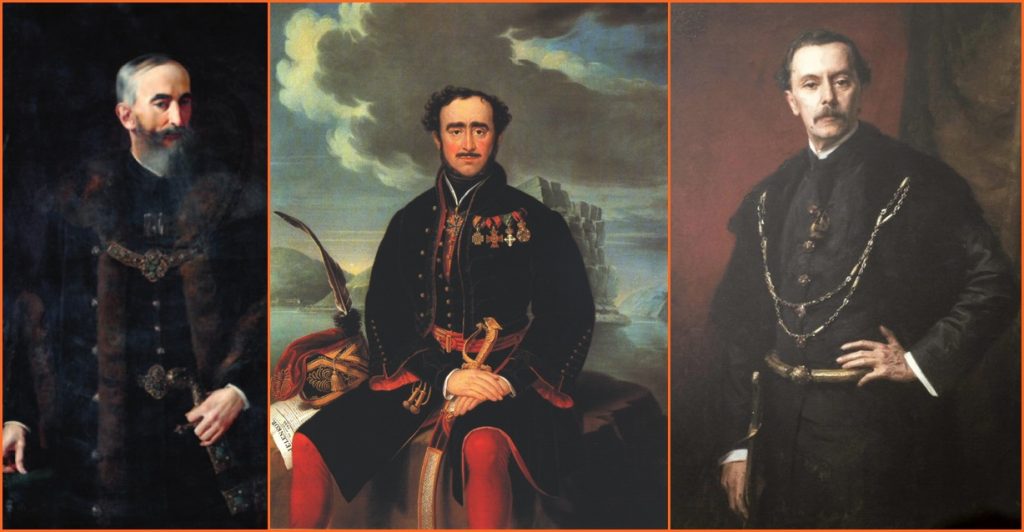The https://english.atlatszo.hu use cookies to track and profile customers such as action tags and pixel tracking on our website to assist our marketing. On our website we use technical, analytical, marketing and preference cookies. These are necessary for our site to work properly and to give us inforamation about how our site is used. See Cookies Policy
The Hungarian National Museum loaned 14 paintings to Viktor Orban’s new office
Viktor Orban’s new, supposedly ‘austere’ offices are decorated with artwork from the most prestigious Hungarian museums. Last week Atlatszo revealed that the prime minister’s new office in the Buda castle has 38 pieces of artwork borrowed from the National Gallery and carpets from the Museum of Applied Arts. Another freedom of information request revealed that besides those, 14 other pieces of artwork were loaned to Orban’s new office by the National Museum. Most of them are portraits of historic Hungarian men – statesmen, warriors, and nobility.
A company called Várgondnokság Nonprofit Ltd. manages the prime minister’s new office and the company borrowed 14 works of art from the Hungarian National Museum until the end of November 2023. Most of the paintings depict famous Hungarian statesmen, e.g. István Széchenyi, István Tisza and Miklós Zrínyi. Among the works rented there are Miklós Barabás’s portrait of Gábor Baross, and Bertalan Székely’s portrait of Count Gyula Andrássy.
This story broke in December 2018 when a few media outlets reported that the prime minister’s new office in the Buda Castle was decorated with carpets borrowed from the Museum of Applied Arts and paintings from the Hungarian National Gallery.
To find out more, at the beginning of January 2019 Átlátszó filed a freedom of information request and asked for a list of works of art borrowed from the Museum of Fine Arts and from the National Gallery by non-public collections (i.e. not museums) between 2015-2018.
The museums’ reply revealed that the state-owned Várgondnokság Nonprofit Ltd. borrowed 34 paintings and 4 statues from the Museum of Fine Arts from 28 November 2018 until 31 December 2023.
Orban’s new, ‘austere’ office decorated with 38 pieces of historic artwork from public museums
Starting January 2019, the Office of the Prime Minister is not in the House of Parliament any longer. Viktor Orban’s office moved into the former Carmelite Monastery in the Buda Castle. The government and its propaganda media emphasize that the new office of the prime minister is simple and austere.
The official ‘place of storage’ during the rental period is 5-7 Színház Street, Budapest, which is the address of the former Carmelite monastery, the prime minister’s new office.
According to Átlátszó’s sources, the Museum of Fine Arts was not the only museum that loaned works of art to the new office of the Prime Minister, therefore we filed a freedom of information request with the Hungarian National Museum as well. Their reply revealed a list of works of art that were borrowed by non-public collections between 2015-2018.
According to the data Várgondnokság Nonprofit Ltd. borrowed 14 paintings from the National Museum from December 1, 2018 until November 30, 2023. The ‘place of storage’ during the rental period is again 5-7 Színház Street, Budapest – that is, Orban’s new office.
The 14 paintings were created by the finest Hungarian portrait painters: Miklós Barabás, Antal Diósy, Géza Hoffmann, Gyula Glatter, Béla Pállik, Ágoston Schöfft, Gyula Stetka, Bertalan Székely, Mór Than and Károly Telepy.
One of these paintings is the portrait of Count Andrássy Gyula which was purchased by the Hungarian Academy of Arts in 2012 for Hungary. In 2014, Deputy Prime Minister Zsolt Semjén visited the painting at the National Museum.
The Hungarian Academy of Arts wrote a short article on the visit, saying: ‘Dr. László Csorba, Director General of the National Museum, personally informed the prestigious guest about the story of the successful rescue of the artwork. Mr. Semjén expressed his satisfaction with the decision of the Academy of Arts and his most sincere wishes.’
Written by Katalin Erdélyi
English version by Zsuzsanna Liptákné Horváth. You can read the original, Hungarian language story here.
Cover image: Montage of Béla Pallik’s portrait of Kálmán Tisza, Ágoston Schöfft’s portrait of István Széchenyi, and Gyula Glatter’s portrait of Miklós Bánffy


